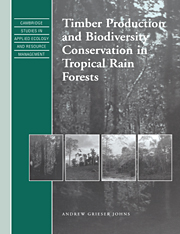Book contents
- Frontmatter
- Contents
- Foreword
- Preface
- Explanatory note
- 1 The issues
- 2 The history and development of tropical forestry
- 3 Changes in the physical environment
- 4 Forest regeneration and gap dynamics
- 5 Responses of individual animal species
- 6 Responses of species assemblages
- 7 Using ecological data in forest management planning
- 8 Intervention to maintain biodiversity
- 9 Field procedures
- 10 The future
- References
- Subject index
Preface
Published online by Cambridge University Press: 04 December 2009
- Frontmatter
- Contents
- Foreword
- Preface
- Explanatory note
- 1 The issues
- 2 The history and development of tropical forestry
- 3 Changes in the physical environment
- 4 Forest regeneration and gap dynamics
- 5 Responses of individual animal species
- 6 Responses of species assemblages
- 7 Using ecological data in forest management planning
- 8 Intervention to maintain biodiversity
- 9 Field procedures
- 10 The future
- References
- Subject index
Summary
In the late 1970s, I was somewhat surprised to find myself conducting the first detailed work on the ecological effects of timber logging in a tropical rain forest. Surprised, that is, that so little had been conducted beforehand. Due mainly to the medium of television, enormous public interest had been kindled concerning the fate of the rain forests. In response to this interest, a flood of popular and scientific books and articles reporting on the consequences of tropical forest loss had been unleashed. The extent of clearance of tropical forest for shifting or plantation agriculture, cattle ranching or other human activities was widely and often acrimoniously debated.
All the fuss focussed exclusively on deforestation, which could conveniently be tracked by satellite technology and did not require much by way of actual field research. After deforestation, timber logging was the second most important human influence on tropical forests. It was known to affect 50 000 km2 of rain forest annually during the late 1970s and 1980s. Yet no-one had considered it appropriate to go into the field to research the effects logging might have on rain forest biodiversity. Forests subjected to timber logging were invariably included within ‘deforestation’ statistics. They were considered as lost to wildlife and ignored in forest conservation strategies.
Look down from an airplane flying over any extant tropical forest and the differences are quite obvious. Areas at the edge of the forest are continually being cleared to support the expanding human populations.
- Type
- Chapter
- Information
- Publisher: Cambridge University PressPrint publication year: 1997

